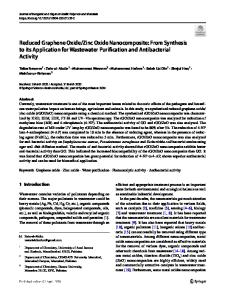Review on synthesis of three-dimensional graphene skeletons and their absorption performance for oily wastewater
- PDF / 7,345,801 Bytes
- 19 Pages / 595.276 x 790.866 pts Page_size
- 61 Downloads / 280 Views
REVIEW ARTICLE
Review on synthesis of three-dimensional graphene skeletons and their absorption performance for oily wastewater Dandan Weng 1 & Leilei Song 2 & Wenxiao Li 1 & Jun Yan 1 & Lei Chen 1
&
Yong Liu 1
Received: 12 June 2020 / Accepted: 21 September 2020 # Springer-Verlag GmbH Germany, part of Springer Nature 2020
Abstract Water pollution is a global environmental problem that affects the ecosystem severely. Treatment of oily wastewater and organic pollutants is a major challenge that waits to be solved as soon as possible. Adsorbing is one of the most effective strategies to deal with this problem. Three-dimensional (3D) porous adsorbents made of graphene or graphene-based nanomaterials skeletons had attracted more attention in wastewater treatment because of their large surface area, high porosity, low density, high chemical/ thermal stability, and steady mechanical properties, which allow different pollutants to easily access and diffuse into 3D networks of adsorbents. This work presents an extensive summarization of recent progress in the synthesis methodologies and microstructures of 3D graphene foams and 3D graphene-based foams and highlights their adsorption performance for oils and organic solvents. Advantages and disadvantages of various preparation strategies are compared and the corresponded structures of these skeletons are studied in detail. Furthermore, the effects of the structures on oil-adsorption properties are analyzed and some data and parameters of the oil-adsorption properties are listed and studied for easier comparison. At last, the future research directions and technical challenges are prospected, which is hoped that the researchers will be inspired to develop the new graphene-based adsorbents. Keywords Three-dimensional graphene skeleton . Foams . Adsorbents . Oil-water separation . Organic pollutants . Nanocomposite
Introduction Water contamination and related environmental concerns have become a hot issue in recent years. Water contamination is caused by dyes, oil spills, organic solvents, and heavy metals released by industry, as well as via changeable accidents. Among them, contamination caused by crude oil and toxic organic solvents (such as cyclohexane, benzene, dichloromethane, and toluene) poses a huge threat to marine Responsible Editor: Tito Roberto Cadaval Jr * Lei Chen [email protected] * Yong Liu [email protected] 1
Key Laboratory of Advanced Braided Composites, Ministry of Education, School of Textile Science and Engineering, Tiangong University, Tianjin 300387, People’s Republic of China
2
AECC Aegis Advanced Protective Technology Co., Ltd, Tianjin 300304, People’s Republic of China
ecosystems and economy(Schrope 2011). For example, the Gulf of Mexico oil spill in 2010 is a typical example, the largest ocean leak in history, which leaked 4.9 million pails of crude oil into the ocean, causing grave harm to fisheries, marine life, tourism, coastal wetlands, and so on (McNutt et al. 2012). The long-term environmental pollution caused by leakage o
Data Loading...











